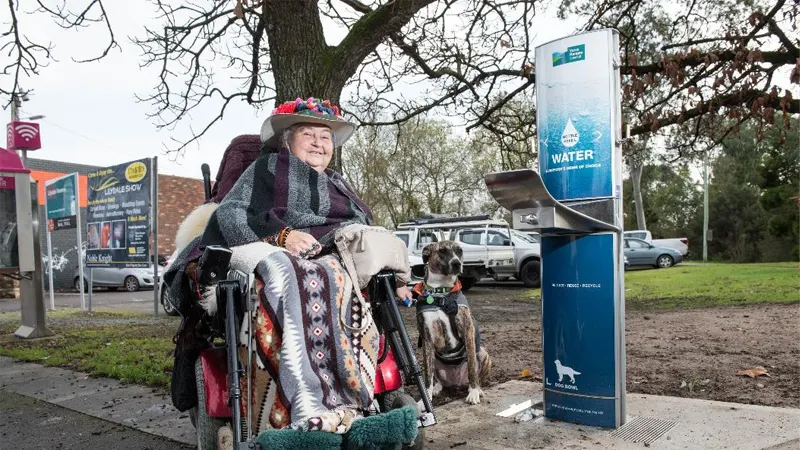
Easy access to community needs for everyone
Part of the Caulfield to Dandenong Level Crossing Removal Project initiated by the Victorian Government, a 17-kilometre shared path for commuters, pedestrians and cyclists has been built to make it easier for citizens to safely access medical, work and university destinations as well as shopping and recreational zones.
The continuous route from Caulfield to the EastLink Trail connects cycle and walking paths that run through transport interchanges and community “activation nodes”, connecting several suburbs through linear parks along what is now called the Djeering Trail — designed by ASPECT Studios and Cox Architecture.
Using underutilised public space to improve public amenity
In a bid to improve public amenity and make use of underutilised or redundant public spaces around Melbourne’s busiest rail corridor, a collaboration between multidisciplinary partners resulted in on of the state’s largest and most public infrastructure projects in recent history, unlocking the potential of the land and transforming it into vital open space for public use.
Spanning Melbourne’s south-eastern suburbs, the project elevated the existing rail line, removing nine ground-level crossings in the process and opening a previously underutilised realm to create new opportunities for community use and connection.
Key features of the Djeering Trail project include: five-station forecourts and associated open spaces, three linear parks and shared user paths, one civic square, five large-scale activation/sport/multigenerational spaces, multiple small community nodes (dog park, fitness stations, picnic, heritage interpretation, and memorial square), as well as integrated water management throughout the parks.

Encouraging commuters to walk, cycle or take the train
The optimised transportation hubs include amenities that encourage a multimodal approach to get around (eg. walking, cycling and train), while the station forecourts are designed to enhance the community experience.
The activation nodes in the linear parks range from small areas with fitness stations, seating and picnic areas to larger neighbourhood locations with playgrounds, dog parks, basketball courts and leisure activities that encourage physical activity and community engagement.
Publicly accessible drinking fountains, engineered to endure outdoor environments
Over 4200 trees were re-established throughout the project, in addition to those trees saved through the elevation of the rail line. And, to support the landscaping, stormwater from the elevated viaduct is captured and discharged at the base of the piers, where it is conveyed through surface swales to the soil to provide passive irrigation.
Contributing to the project’s amenity, publicly accessible drinking fountains with water bottle refill and dog-watering stations are spread along the trail at several transport hubs and activation zones. Designed and supplied by specialists in public-use products, Civiq, the Aquafil Bold 850BF drinking fountains supplied to the project are engineered to endure outdoor environments.

Robust, flexible, functional and vandal resistant
After putting much research into finding a product that would meet the project brief for DDA-compliance, robust construction, flexible functionality, vandal resistance and the ability to withstand the rigours of public use, the Aquafil Bold 850BF was specified by the Chief Engineer of the Level Crossing Removal Project.
Displaying a strong, sleek stainless steel design, the Aquafil Bold has a protective rubber mouth guard, an antibacterial bottle refill nozzle, and a dog drinking bowl accessory.
And, the optional signage panel allows councils to include branded advertising, wayfinding or historical signage for public space users.
Visually appealing, inclusively accessible, compliant and certified
At a height of 850mm, the robust stainless steel construction and sculptural form of the Aquafil Bold drinking fountain makes it a visually appealing solution for outdoor settings. Compliant with ASNZ 4020 standards, it is also a DDA-compliant wheelchair-accessible design; an important consideration for today’s inclusive public environments.
In addition, the Aquafil Bold is WaterMark Certified — one of the few lead-free certified drinking fountains on the Australian market. The WaterMark Certification Scheme is a mandatory evaluation, certification and authorisation system for plumbing and drainage products. WaterMark ensures these products are fit for purpose and appropriately authorised for use in civil plumbing and drainage installations.
Good for the environment, easy to use and visually appealing, the Aquafil Bold 850BF was a solid choice that improves the functionality of the multiple spaces in which they were installed and meets the high-quality finish required of the project vision. Delivering immediate public value for communities, the Djeering Trail is a legacy space for users — proudly hydrated by Civiq!


